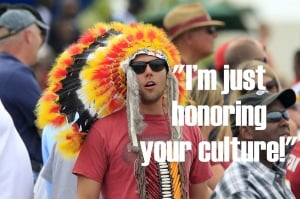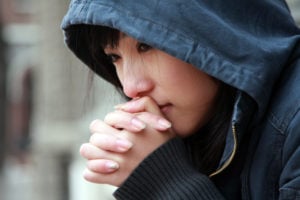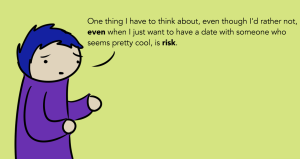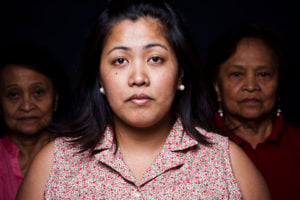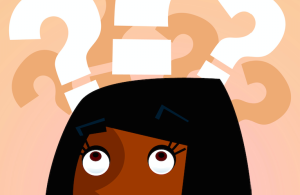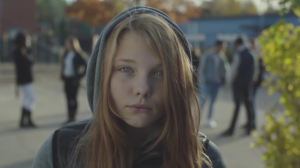Originally published on The Rumpus and cross-posted here with permission.
My senior year in Chapel Hill, I finally got up the courage to take a course in Asian American literature. Stupidly, I treated it as a little experiment. As an adoptee, I had grown up with white parents in a white town in rural Connecticut. My only knowledge of Asian culture was Chinese food and, when I was growing up, a number of meetings of adopted children that still haunt me, though I realize that my parents had my best interests at heart. They had taken me to these meetings for connection, but what I remember was the disconnect: the awkwardness of forced interaction between children who thought of themselves as white and didn’t want to be shown otherwise. We hated being categorized as adoptees, or I did and I read those feelings into the others, who to me did not seem friendly, or familiar, only more strange for their yellow faces.
Those meetings made me feel classified by my parents as other. One of the things I most remember from that time (and from books like We Adopted You, Benjamin Koo) is the common experience that the adopted child has when one day he looks into the mirror and all of a sudden realizes that his skin color is not the same as his parents’. Up until that moment, he sees himself as white (in the case that the parents are white). I saw myself as white. When I closed my eyes, or when I was in a conversation and seemed to be watching from above, I was a skinny white boy, a combination of my parents, just like other kids.
Sometimes, if I am being honest, I still catch myself looking down at my conversations with white people and picturing myself, in that strange ongoing record in my head, as no different from them. As a boy, the one thing that nagged at me was the flatness of my nose. I was constantly tugging on it, thinking that I could stretch it out and thereby gain acceptance.
But let me pause here for a moment. This is going to be a difficult essay to write, and I want to prepare myself—and you, reader—by coming at this topic from a larger angle.
Right now, it seems to me that a similar type of self-contextualizing (through race) is happening on a grand scale in Asian America, as Jeremy Lin takes over sports news and much of AA media references. With Lin’s rise, there has been a feeling, a swelling collective feeling, that we Asians are no different from the other people we see on national TV, almost exclusively white and black. That we are Jeremy Lin, able to play as well as they in “their” arena, the ability of Jeremy Lin pointing to a potential in all of us.
The writer Jay Caspian Kang says something to this effect in his Grantland article: “The pride we feel over [Lin’s] accomplishments is deeply personal and cuts across discomforting truths that many of us have never discussed. It’s why a headline that reads ‘Chink in the Armor,’ or Jason Whitlock’s tweeted joke about ‘two inches of pain,’ stings with a new intensity. Try to understand, everything said about Jeremy Lin, whether glowing, dismissive, or bigoted, doubles as a referendum on where we, as a people, stand.”
When the disparagements came—as we feared and maybe suspected they would but hoped they wouldn’t—it was like that first time looking in the mirror. We realized that for all of Jeremy Lin’s accomplishments, we as Asians are still different, are still seen differently than other races by the vast majority of Americans.
 The truth is, racism toward Asians is treated differently in America than racism toward other ethnic groups. This is a truth all Asian Americans know. While the same racist may hold back terms he sees as off-limits toward other minorities, he will often not hesitate to call an Asian person a chink, as Jeremy Lin was referred to, or talk about that Asian person as if he must know karate, or call him Bruce Lee, or consider him weak or effeminate, or so on. Bullying against Asian Americans continues at the highest rate of any ethnic group. I remember, when I was taking the Asian American literature course, an article in a major magazine that ran pictures of (male) Asian models above the tagline, “Gay or Asian?” I remember a video that went viral last year in which people explained why men prefer Asian women and why women dislike Asian men. Some of the women on the video were Asian American.
The truth is, racism toward Asians is treated differently in America than racism toward other ethnic groups. This is a truth all Asian Americans know. While the same racist may hold back terms he sees as off-limits toward other minorities, he will often not hesitate to call an Asian person a chink, as Jeremy Lin was referred to, or talk about that Asian person as if he must know karate, or call him Bruce Lee, or consider him weak or effeminate, or so on. Bullying against Asian Americans continues at the highest rate of any ethnic group. I remember, when I was taking the Asian American literature course, an article in a major magazine that ran pictures of (male) Asian models above the tagline, “Gay or Asian?” I remember a video that went viral last year in which people explained why men prefer Asian women and why women dislike Asian men. Some of the women on the video were Asian American.
As I said, I was treating the AA literature course as an experiment. There were a few white students in class who laughed at the “Gay or Asian?” tag and found little offensive about it, at least until pressed. Maybe the first sign that my experiment was working was the anger I felt toward them. The test, you see, was secretly how Asian I was, or maybe whether I was Asian at all. It was something to do with discovering myself, and how much that self was formed by my birth, which I knew nothing about, and by my birth mother, who had abandoned me, and by the country that had raised me while leaving scars of unknown origin on various parts of my body.
College can be a chance to remake oneself, or to get closer to the foundation of oneself that one gradually moves away from under the influence of peers. I had, in fact, as soon as I got to UNC, attempted to join the Asian American club, but I couldn’t get over how cliquish they seemed, embracing their strangeness, while the truth is that I was trying to get away from those differences. Soon I found myself, with this second chance, once again trying to be accepted by people who looked like my parents, telling myself I didn’t want to be Asian if this was what being Asian meant, being birds of a different feather, expected to be an automatic friend because of race. I had, as you can see, my excuses.
Yet somewhere inside of me, I must have felt that I was growing further from myself. Racist jokes were told with alarming frequency for a school billed the “most liberal in the South,” and I was friends with two groups: one mostly white, mostly Southerners in the same dorm; the other mostly black, with whom I played pick-up basketball. They joked without censor. I had a girlfriend whose aunt and uncle lived in North Carolina, and when we went to visit, they would say that at least I wasn’t black, often before some racist diatribe. This seemed the predominant sentiment then. At least I wasn’t ____.
I was taking the AA course to find out what I was. I hadn’t read much Asian American literature at that time—I think almost all I could add to the class discussion was Michael Ondaatje—and a couple of books planted seeds in me then that would grow into a certain self-awareness later in life. I will always be grateful to Don Lee’s story collection, Yellow. In Lee’s stories, Asian American characters experience racist incident after racist incident, but these incidents are mostly background to their lives as sculptors, surfers, lovers, etc. The characters are very much of the world in which they live, the world in which I lived and a different world than the one in which white people live with the privilege of their color. In class, the white students were incredulous. They claimed such acts of racism could never happen with such frequency. Yet if anything, to me, the racism seemed infrequent, and with minimal effect on the characters’ lives.
I had grown up constantly wavering between denying and suspecting that my skin color was behind the fights picked with me, the insults, the casual distance kept up even between myself and some of my closest friends. Sometimes—in retrospect: oftentimes—these incidents were obviously rooted in race. I have been called “chink” and “flat face” and “monkey” many many times. And it is the context of these words that make a child grow uncomfortable with who he is, that instill a deep fear in him. (As a side note: I am married now to a Korean woman who grew up in Korea, and when I mentioned the “flat face” slur to her, she said, “but your face is flat.” Yet how different was this from the leering way it was said to me as a child, something she hadn’t felt as a Korean in Korea.) I was afraid, back then, of myself, as if there were a little Asian person living within me that was corrupting my being, taking me away from the white person I thought I was.
There are still incidents from those days that I cannot get out of my mind. I remember watching, in one middle school class, a video meant to teach us that blackface and sculptures of big-lipped black people and stereotypes of watermelon and fried chicken were wrong. Later that same year, one of my best friends drew a picture of a square with a nose poking off of one side. I knew this was me even before he said it. Sometimes my friends would ask me to do the trick where I put my face against the table, touching both my forehead and my chin to the wood. I thought of this as a special ability, but underneath, I knew I should be ashamed.
I would bet that this friend does not remember drawing me in that one science class. We often drew together. He was in all of my classes that year, as we were allowed two friends to share a similar schedule, and I was the only one who requested him. That he wouldn’t remember this drawing is part of the problem, I know now. He thought of the picture as a joke, though I had never seen him draw caricatures or draw anyone else so simply. Surely a part of him knew what he was doing but didn’t stop him. There was no video to tell him not to—there was no one to tell him not to, even me. I pretended it didn’t bother me.
That was the same year my closest childhood friend suddenly cut me off. We had been inseparable, but at the start of that school year, he made fun of me and seemed to use this attack to springboard into popularity. I spent many nights during those first few weeks of school crying myself to sleep, not understanding why we weren’t friends anymore. It is a wound that still hurts—as I type this, I find my face heating up and my breaths deepening. I still don’t understand completely, but I can point to the fear that this was due to the color of my skin, more than anything, as an indication that it indeed was. I understood even when I didn’t understand, as children can.
In response to the students who didn’t believe the frequency/viciousness of the racism inYellow, the professor showed us an  interview in which Lee says every incident in the book has happened to him. Or perhaps I found this interview later, I don’t remember now. As a matter of research, I thought I would ask a few Asian American authors I know about racist incidents in their books that are based on events that happened to them.
interview in which Lee says every incident in the book has happened to him. Or perhaps I found this interview later, I don’t remember now. As a matter of research, I thought I would ask a few Asian American authors I know about racist incidents in their books that are based on events that happened to them.
Earlier this year, Salon ran a piece by Marie Myung-Ok Lee about a bully who made it into her novel and whom she finally, after many years, confronted. I heard from several writers about experiences making it into their books: how they were unable to get away from writing about those experiences, as unable as they were to stop thinking about them, but hardly anyone seemed to want to call out those past attackers. I spoke with one writer about the condition of anonymity, as the people who had hurt him most were those closest to him.
I think what all of this says to me is that 1. these things happen to all of us, and 2. they leave the type of mark that we cannot escape, that we return to again and again, as writers do.
A few years after UNC, when I was an MFA student at Emerson College (where Don Lee got his MFA and then later edited Ploughshares and taught), there was a rumor going around that in the original workshop stories from Yellow, the characters were white. That Lee made them Asian later. I’m not sure the truth of this statement. In fact, I’m not interested in the truth of it. I’m more interested in the fact that this was a rumor at all. This was something people wanted to talk about, and talked about as if the truer versions of the characters were white. If Lee did use white characters, originally, he is not alone. I know many Asian American writers who refuse to write about Asian Americans, out of a fear of being typecast, or a fear of being seen as “using” their ethnicity, or a fear of being an “Asian American writer,” or something. And really, I understand that. I have been one of those writers. This may not come as a surprise, at this point in this essay, but for a long time, I wrote only about white characters. I wrote about them because I grew up with people like them, but also because they were the people in books and because I, too, feared the label, or at least told myself I did. What that fear really is, it seems to me now, is a fear of not being taken as seriously as the White Male Writer, who has so long ruled English literature.
The breakthrough came when I started to be able to read my own stories objectively. Something was not making sense. Why were my characters who they were? I inserted plenty of flashbacks and backstory to try to “explain” them. But in the end, I realized that what they were missing, in many cases, was a crucial piece of me that had gone into them. They were Asian, like me. Many of them were adopted, like me. The original characters were not the truecharacters. And “changing” them to Koreans made everything make sense.
For my day job, I organize a seminar at Harvard on the topic of Inequality. I attend these talks both out of responsibility and out of interest. But after two and a half years, I can only remember Asians being mentioned twice, once in direct response to a question by an Asian student. I remember sitting beside another Asian American student and listening to a lecture earlier this year. He said something like, “Nobody ever talks about Asians,” and I said, “Asians don’t exist in Sociology.” We both laughed. It was a joke, but it stung with a certain truth. The time Asians were mentioned not in answer to a question was in reference to university admissions—a heated topic now in the AA community—as numbers show that students of Asian descent make up a disproportionately large percentage of admissions to top schools.
Often I have heard Asians talking about these percentages with pride, even in responding to racism. If attacked, they “point to the scoreboard” of college admissions. Yet it is a very real complaint that Asian descent seems to count against us in those same admissions numbers. Both Harvard and Princeton are currently under investigation on charges of racism toward Asians, whose grades and SAT scores, on average, must be higher than those of other races in order to gain admissions. Many Asian Americans are responding by marking the box on applications that declines to indicate race, something I cannot help but read symbolically. I confess that I would give my daughter that exact advice, in admissions: not to reveal her race. The accusation is that schools have capped their “quotas” of Asian students, and this is why Asians need to score higher, because they are competing amongst themselves for a limited number of spots. Most Asians accept the unwritten rules, pushing themselves or their children harder. But why should they, in a country that prides itself on equal opportunity?
To bring up college admissions is often to be met with the complaint that we should be happy with the success we have. In fact, success is often used as a justification for why Asians are ignored in discussions of inequality. I was forgetting a third mention of Asian Americans in the seminars: as a group other immigrant races should look toward as an example of successful assimilation. Why aren’t we happy with our disproportionate admissions and the many children who grow up to be doctors and lawyers, pushed by their parents? (The more sarcastic answer: why aren’t white people happy enough with EVERYTHING?)
Jeremy Lin, early in his success, was called out by boxer Floyd Mayweather as only getting the attention he was getting because he is Asian, since every day black athletes accomplish what Lin has and receive no fanfare. Or something to this effect. Other journalists responded by saying Lin is getting the attention because he worked so hard and is the ultimate underdog. Both these points, it seems to me, have a lot to do with race. Why was Lin an underdog, ignored by scouts when he had succeeded at every level and outplayed the best point guards he faced (see: John Wall, Kemba Walker)? Writers always seem to mention how hard Lin works, and often mention this as a trait of Asian Americans. They mention that he went to Harvard, how smart he is. They mention that he is humble. When I wrote about the “Chink in the Armor” headline for the Good Men Project, a commenter responded by pointing to Asian Americans being too respectful to speak up against racism. This respectfulness, he said, was something he admired about Asians.
It is hard to call someone who thinks he is complimenting you a racist. But the positive stereotypes people think they can use because of their “positivity” continue (and worsen) the problem. Thinking you can call an entire race “respectful” is thinking you can classify someone by race, is racism. Which is what is happening to Jeremy Lin when he is called “hard-working” instead of “skilled,” when his talent is marginalized by a writer who sees him as the Asian American stereotype, the child of immigrants who outworks and outstudies everyone else. Mayweather has one point, at least—other athletes work as hard or harder than Jeremy Lin. I’ve seen the videos of Lin’s workouts, how intense they are, how long, but this is not unusual for a basketball star. Read about Kobe Bryant’s work ethic, or Ray Allen’s, either of which put Jeremy Lin to shame. Jeremy Lin is the success he is because of his individual talent, not because he is Asian American. His ethnicity, I would have to argue, was only a factor in him having to “come out of nowhere,” since that was where Asians have been relegated to in sports.
After ESPN ran the “Chink in the Armor” headline, the writer of the headline made a very defensive apology in which he claimed to be a “good person” who didn’t know the weight of the word he was using. He was fired, and this apology came afterward. When he was first fired, I felt sorry for him. I didn’t think he deserved to lose his job but then his defensiveness came and took that sympathy away. Some on my Twitter feed suggested he didn’t know the term because of his young age. He is 28. I am 29. “Chink” is a very common term, probably the most common slur against Asians, and this was a writer and (I’m assuming) a reader who made his livelihood online. I find it impossible to believe that he hadn’t come across the term in some way. It bothers me to see people make excuses for him. “I’m sorry, but” is not “I’m sorry.” If you believe you can get away with the excuse, then what is that telling me?
A few years after I graduated from UNC, I decided to go to Korea. I had never been back. I was still writing white characters, though I had let a Korean American slip into my novel in a supporting role, a character who never finished his sentences, who was always cut-off or cutting himself off. I was still searching for that Korean part of me. I had spent a long winter in Prague as one of the only Asians in the city, strange in a strange land. In Korea, I fell apart immediately. I ended up losing twenty pounds in two weeks, and I would have run back to the States if not for meeting my wife.
But then a strange thing happened. I got used to seeing Koreans, and was surprised whenever I saw a white person. And after some time, not like the sudden realization in the mirror but a gradual process, I began to see myself as a person from this country. I wrote my first story with a Korean character, and something in it, the vulnerability, the honesty, clicked. In Korea, I had different differences than in America. Not that race was out of the picture—the biggest shock to people was my culture, in spite of my skin color, my inability to speak Korean—but it was like looking at race from the inside out, the opposite of how I had been forced to see myself my whole life. It was a lesson: that I had control over my differences, that I could choose to build them up or break them down, that they were not simply genetic, something that had never been true in America.
Search our 3000+ articles!
Read our articles about:
Our online racial justice training
Used by hundreds of universities, non-profits, and businesses.
Click to learn more







